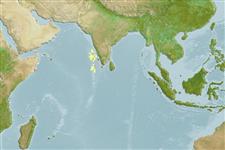Elasmobranchii (tubarões e raias) (sharks and rays) >
Torpediniformes (Electric rays) >
Narcinidae (Numbfishes)
Etymology: Benthobatis: Greek, benthos = depth of the sea + Greek, batis, -idos = a ray (Raja sp.) (Ref. 45335); moresbyi: Named for Capt. Moresby of the Indian Navy..
More on author: Alcock.
Environment: milieu / climate zone / depth range / distribution range
Ecologia
marinhas batidemersal; intervalo de profundidade 787 - 1071 m (Ref. 48493). Deep-water; 15°N - 5°N, 49°E - 77°E (Ref. 114953)
Indian Ocean: Arabian and Laccadive seas (off Travancore coast), Yemen and Somalia; including India (Ref. 118627).
Tamanho / Peso / Idade
Maturity: Lm ? range ? - ? cm
Max length : 35.1 cm TL macho/indeterminado; (Ref. 48493); 39.2 cm TL (female)
Descrição breve
Morfologia | Morfometria
Dark brown dorsal and ventral surfaces; ventral entirely dark. Snout elongated, usually more than 1/3 in disc length (preocular snout region 40% in disc length in lectotype). Disc oval, longer than wide. Dorsal fins with long, fleshy bases which are much longer than height of the fin (dorsal fin length 50-55% of fin height). Origin of first dorsal well anterior to posterior tip of pelvic fins, close to mid pelvic length; dorsal fins close together, interdorsal space less than length of dorsal bases. Distance between second dorsal and caudal fins much smaller than length of base of second dorsal fin. Caudal fin extremely elongated, reaching almost 1/2 tail length as measured from posterior tips of pelvic fins; caudal fin length 40.4% of distance between cloaca and caudal fin tip (Ref. 48493).
A benthic species on continental slope. Probably suction feeds on bottom-dwelling invertebrates based on its oral morphology. Biology little known. Maturity size uncertain, probably close to 18 cm TL in males (Ref. 114953).
Life cycle and mating behavior
Maturidade | Reprodução | Desova | Ovos | Fecundidade | Larvas
de Carvalho, M.R., 1999. A synopsis of the deep-sea genus Benthobatis Alcock, with a redescription of the type species Benthobatis moresbyi Alcock, 1898 (Chondrichthyes, Torpediniformes, Narcinidae). p. 231-255. In Séret B. & J.-Y. Sire [eds]. Proc. 5th Indo-Pac. Fish Conf., Noumea, 1997. (Ref. 48493)
Categoria na Lista Vermelha da IUCN (Ref. 130435)
Ameaça para o homem
Harmless
Utilização humana
Mais informação
Idade/TamanhoCrescimentoComprimento-pesoComprimento-comprimentoFrequência de comprimentoMorfometriaMorfologiaLarvasDinâmica larvarRecrutamentoAbundânciaBRUVS
ReferênciasAquaculturaPerfil para aquaculturaEstirpesGenéticaElectrophoresesHereditariedadeDoençasProcessamentoNutrientsMass conversion
ColaboradoresFotografiasStamps, Coins Misc.SonsCiguateraVelocidadeTipo de nataçãoÁrea branquialOutras referênciasCérebrosVisão
Ferramentas
Relatórios especiais
Descarregue XML
Fontes da internet
Estimates based on models
Preferred temperature (Ref.
123201): 2.7 - 6.7, mean 6.3 °C (based on 5 cells).
Phylogenetic diversity index (Ref.
82804): PD
50 = 0.5625 [Uniqueness, from 0.5 = low to 2.0 = high].
Bayesian length-weight: a=0.01175 (0.00476 - 0.02897), b=2.88 (2.66 - 3.10), in cm total length, based on LWR estimates for this (Sub)family-body shape (Ref.
93245).
Nível Trófico (Ref.
69278): 3.3 ±0.4 se; based on size and trophs of closest relatives
Resiliência (Ref.
120179): Baixo, tempo mínimo de duplicação da população 4,5 - 14 anos (Assuming fecundity<100).
Fishing Vulnerability (Ref.
59153): Low to moderate vulnerability (29 of 100).
